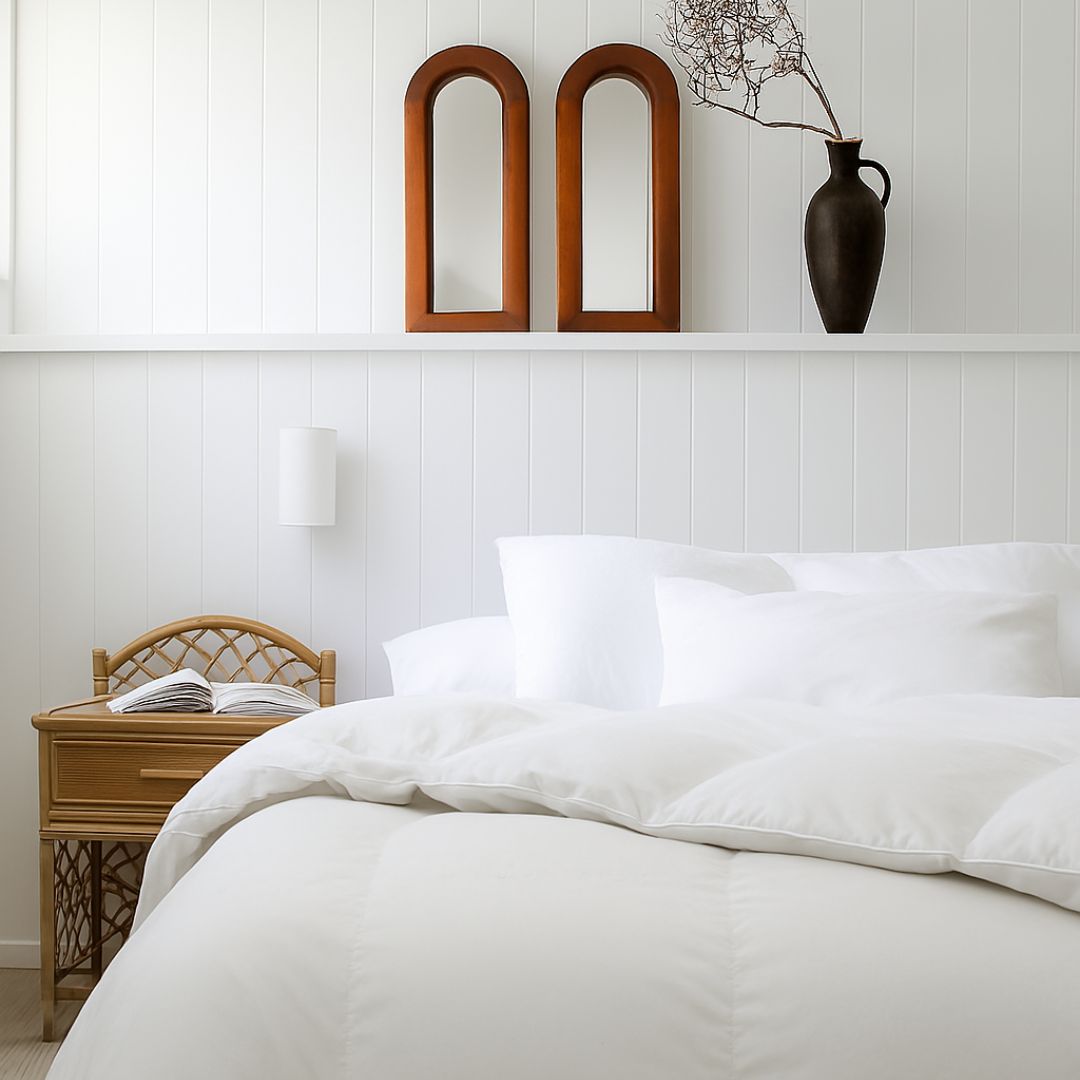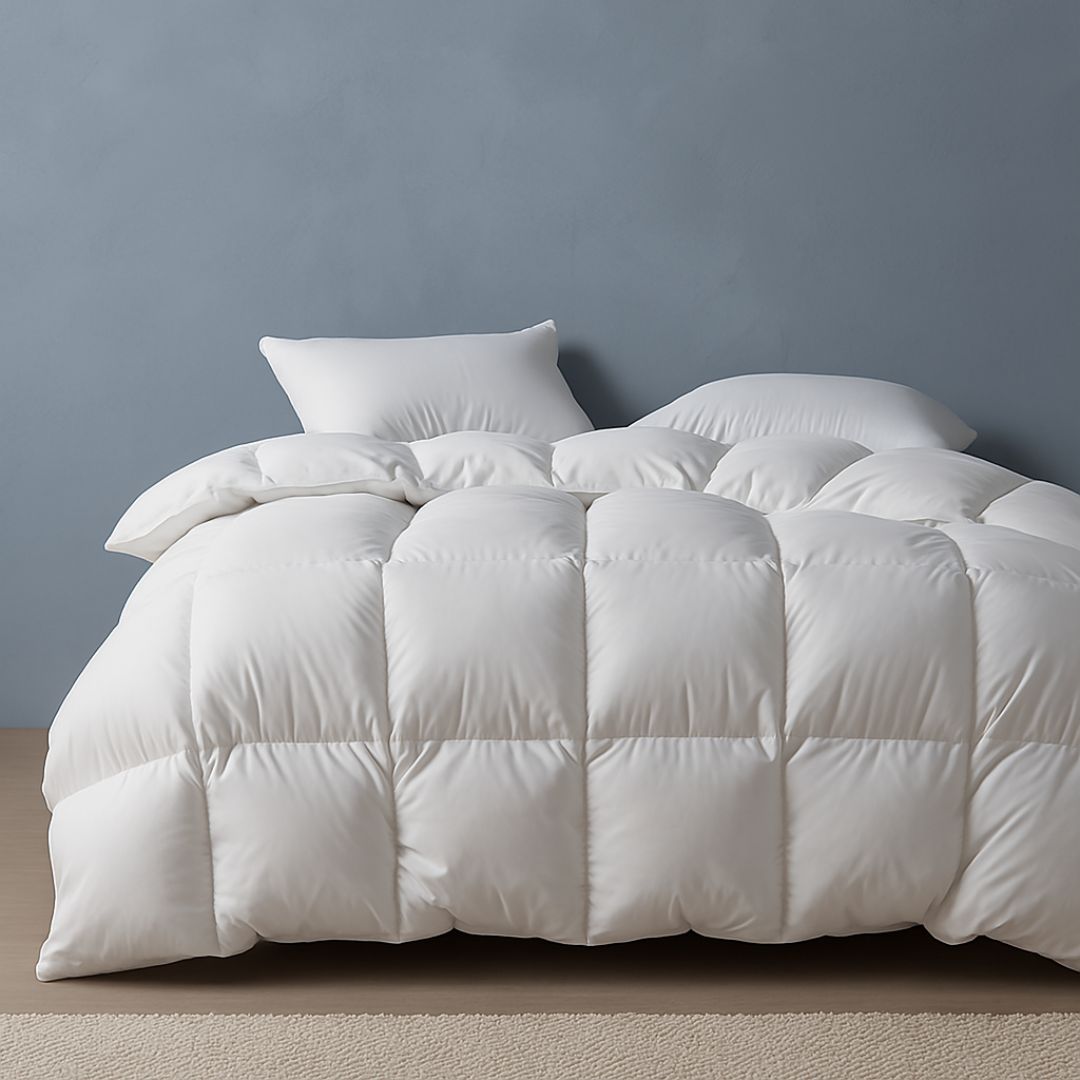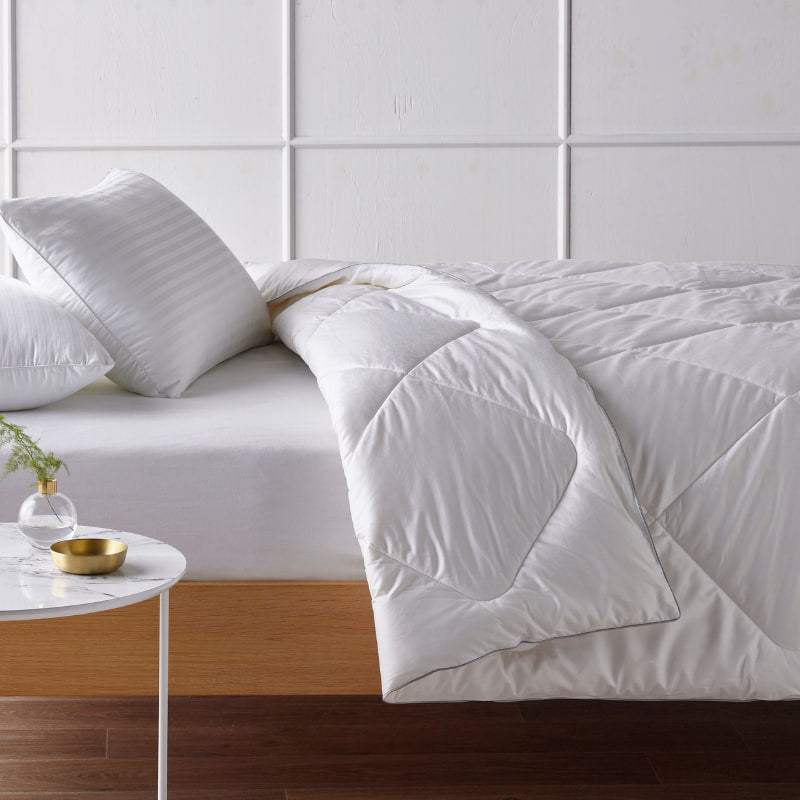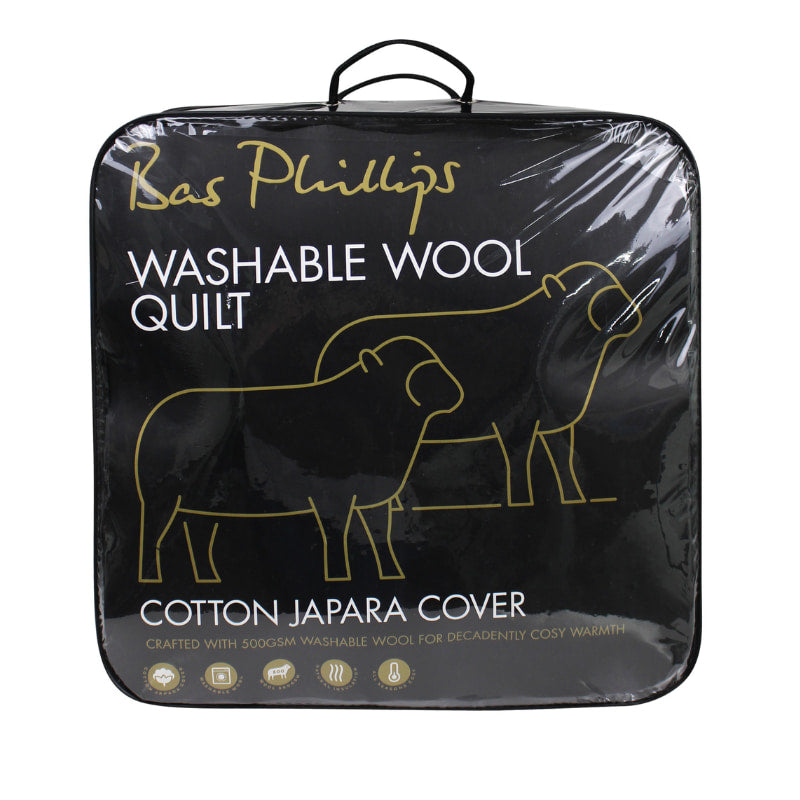Last updated: May 2025
Quick Overview
Struggling to stay warm during those chilly Aussie nights? This guide walks you through the best quilt options for winter. What GSM really means, how to choose the right fill (down, wool, bamboo, or microfibre), and which quilt is best for your climate, sleep style, and budget. Whether you're in Tassie or sunny Queensland, you'll leave with the confidence to choose a quilt that keeps you warm and cosy all season long.
Cold Toes and Heavy Doonas: Sound Familiar?
There’s something about Australian winters that sneaks up on you. One week, you’re sleeping with the fan on and the next, you’re curled into a tight ball under a doona that still isn’t warm enough.
If you’ve ever asked yourself, "What is the warmest quilt for winter in Australia?" or "Why am I still cold with a doona on?"—you’re not alone.
Let’s fix that.
What Makes a Quilt Truly Warm?
Warmth isn’t just about thickness. It’s about:
-
Filling Material – Different fibres trap and retain heat differently.
-
GSM (Grams per Square Metre) – The higher the GSM, the warmer the quilt.
-
Loft – More loft = more insulating air pockets.
-
Breathability – You want to stay warm, not sweaty.
Let’s break it down.
"We have just purchased the 80% duck down and feather quilt, and we are incredibly happy with the purchase. It is light but snuggly warm, and a definite must in these colder months - we are also very happy to know that the filling was responsibly sourced and that no animals were harmed in the production process. Thank you!" - Tanya
( Sienna Living 80% Duck Down 20% Feather Quilt )
What is GSM and Why Should You Care?
Think of GSM as the quilt’s "weight class." More GSM means more fill, and more fill usually means more warmth.
Here’s a quick GSM guide we use at Manchester Factory:
-
200–300 GSM → Summer or hot sleeper
-
300–400 GSM → All-season comfort
-
400–600 GSM → Winter quilt range (perfect for most Aussie winters)
If you're waking up cold and your quilt is under 400 GSM, it’s probably time to upgrade.
What’s the Difference Between TOG and GSM?
If you’ve ever shopped for bedding online—especially from UK or European sites—you’ve probably come across TOG ratings. But here in Australia, we mostly use GSM. So what’s the difference?
-
TOG (Thermal Overall Grade) is a measure of how well a quilt retains heat. It’s a scale (typically 1–15) used in the UK to indicate warmth. The higher the TOG, the warmer the quilt.
-
GSM (Grams per Square Metre) measures the weight of the filling inside the quilt. More weight generally means more insulation and therefore more warmth.
Think of TOG as how warm the quilt feels, while GSM tells you how much fill is inside.
Quick Conversion Guide (Approximate):
-
3–4.5 TOG ≈ 150–250 GSM (Summer)
-
7.5–10.5 TOG ≈ 300–400 GSM (All Seasons)
-
12–15 TOG ≈ 450–600 GSM (Winter)
In Australia, GSM is more relevant because it directly reflects the quilt’s fill weight—especially when comparing natural vs synthetic materials.
What Is Loft in a Quilt?
Loft refers to how thick and fluffy a quilt appears due to the amount and type of filling inside. It’s the height or puffiness of the quilt when it’s laid flat. A higher loft generally means better insulation, as it traps more warm air between the fibres. However, a quilt can have high loft and still be lightweight, especially if it’s filled with premium down. When shopping for winter quilts, aim for a high-loft option to maximise warmth without adding unnecessary weight.
How to Choose the Right Winter Quilt
Everyone’s version of comfort is different, but here’s what to consider:
Know Your Bedroom Temperature
If your bedroom drops below 15°C at night, a 500 GSM or down-filled quilt will serve you best alternativitly a snuggle fleece comforter.
Choose Your Fill Wisely
Here’s where it gets personal. Each material feels different and performs differently:
-
Down & Feather Quilts
Best for: Cold sleepers, luxury lovers.
Why: Warmest and lightest combo. Great loft. Breathable.
Watch out for: Allergies (unless hypoallergenic down) -
Wool Quilts
Best for: People who overheat but still want warmth.
Why: Breathes well, wicks moisture, naturally insulating.
Watch out for: Heavier feel, may feel dense -
Bamboo Quilts
Best for: Hot sleepers in cold climates.
Why: Light, breathable, antimicrobial.
Watch out for: Less warm than down/wool -
Microfibre & Polyester Quilts
Best for: Budget-conscious, allergy-sensitive shoppers.
Why: Hypoallergenic, easy to wash, retains warmth well.
Watch out for: Can lack breathability
Is 400 GSM a Warm Quilt for Winter?
Yes—but it depends on where you live and how you sleep.
A 400GSM quilt is generally considered a light-to-midweight winter quilt in Australia. It’s warm enough for mild to moderately cold climates like Sydney, Brisbane, or coastal areas, especially if you sleep in a well-insulated home or layer with warm sheets.
But if you live in a colder region like Melbourne, Canberra, or Tasmania, or you're a cold sleeper, you might find a 500GSM or down-filled quilt better suited to keeping you truly toasty through winter.
Should You Upsize Your Quilt?
Absolutely. Going up a size (e.g. King quilt on a Queen bed) means:
-
Fewer drafts
-
More snuggly coverage
-
No fighting over edges
Read more: 4 Reasons to Upsize Your Quilt
Quilt Comparison Table (Quick Cheat Sheet)
| Quilt Type | Warmth Level | Breathabilty | Hypoallergenic | Best For | ||||
| Down & Feather |
|
|
|
Cold Climates, Luxe feel | ||||
| Wool |
|
|
✅ Yes | Moisture Control | ||||
| Bamboo |
|
|
✅ Yes | Hot sleepers Layering | ||||
| Microfibre/Polyester |
|
|
✅ Yes | Budget Friendly, Easy care | ||||
| Snuggle Fleece Comforter |
|
|
✅ Yes | All the above |
How Often Should You Replace Your Winter Quilt?
Even the best quilt loses loft over time. Here’s a rule of thumb:
-
Synthetic quilts: Replace every 5–7 years
-
Down or wool quilts: Can last 8–10+ years with care
Some down quilts (like those from Australian brands) can be rejuvenated, such as our Sienna Living down range, which means the fill is replaced without buying a new one from our manufacturer right here in Australia.
👉 Related: How Often Should You Wash & Replace Bedding?
Care Tips to Keep Your Quilt Warmer for Longer
-
Always use a quilt cover (protects from sweat, spills, and dust)
-
Air it out monthly to restore loft
-
Follow the care tag: some are machine washable, others need dry cleaning
-
Store in a breathable bag, when not in use

Shop Our Top-Rated Winter Quilts
If you’re still waking up cold or weighed down by a bulky doona, maybe it’s time to make the switch. These are some of our warmest, most popular picks:
-
Sienna Living Goose Down Quilt
👉 Browse the full winter quilt collection
"I was staying in a poorly heated apartment and I got this hoping it would help. It was perfect and the Queen fit the queen bed with enough to drop over the sides."- Teri ( Sienna Living 80% Down 20% Duck Feather Quilt)
What Are Alternatives to a Traditional Quilt?
If you're tired of wrestling with quilt covers or waking up with your doona bunched at your feet, you're not alone. Many Australians are switching to quilt alternatives that offer warmth and convenience in one.
Popular Alternatives Include:
-
Comforters: All-in-one bedding that doesn’t require a cover.
-
Blanket layering: Using multiple lighter blankets instead of one heavy quilt.
-
Weighted blankets: Provide warmth plus gentle pressure for better sleep.
One standout alternative? The Morgan & Reid Snuggle Fleece Comforter. It’s ultra-soft, machine washable, and warm enough to ditch the doona altogether. No covers, no stuffing just pure snuggly comfort.
👉 Shop the Snuggle Fleece Comforter
Which Quilt Should I Choose?
| If You...... | Go For...... |
| Sleep cold even in mild climates | Down Quilt , 500gsm+ |
| Overheat Easy | Wool, Bamboo,400 Gsm |
| Want all-in-one simplicity | Snuggle Fleece Comforter |
| Have Allergers | Treated Down , Bamboo , Mircofibre |
| Need Something Machine Washable | Bamboo, Snuggle Fleece Comforter, Mircrofibre |
| Want Natural Fibres | Wool or Bamboo |
| Prefer Something Breathable | Wool or Bamboo |
Frequently Asked Questions
What is the warmest quilt for winter in Australia?
The warmest quilt for winter in Australia is typically a high-GSM down or feather quilt, ideally 500 GSM or above. These quilts trap heat efficiently while remaining lightweight. Wool quilts also offer excellent warmth and natural breathability.
Is 500 GSM warm enough for Australian winters?
Yes, a 500 GSM quilt is generally warm enough for most Australian climates. For colder regions like Tasmania or Canberra, a 500 GSM down quilt offers ideal insulation without bulk.
Which is warmer: wool or down quilt?
Down quilts tend to be warmer due to their superior loft and insulation properties, but wool quilts provide consistent warmth while also regulating temperature and moisture—making them ideal for hot sleepers who still need winter warmth.
What’s the best quilt material for hot sleepers?
Bamboo or wool quilts are best for hot sleepers. Both materials are breathable and moisture-wicking, keeping you warm without overheating during the night.
How often should I replace my winter quilt?
You should replace your quilt every 5–7 years, depending on the material and how well it’s maintained. High-quality down or wool quilts can last up to 10 years or more with proper care.
Can I wash my winter quilt at home?
It depends on the fill. Microfibre and some bamboo quilts are machine-washable, while wool and down quilts may require professional cleaning. Always check the care label.
Final Summary: How to Choose the Warmest Quilt for Winter
Choosing the right winter quilt isn’t just about buying the thickest one you can find. It’s about knowing your sleep style, climate, and what materials will keep you warm without overheating. For most Aussie homes, a 400–500 GSM quilt in wool or down hits the sweet spot. Bamboo is perfect for hot sleepers, and microfibre works great for families who want something affordable and washable.
Whatever your choice, invest in quality, and your winter nights will thank you for it.
👉 Shop Manchester Factory's best-selling winter quilts
Written by Jess at Manchester Factory
We've been helping Australians sleep better for over a decade, with bedding that's warm, practical, and thoughtfully made. Every Snuggle Comforter is developed with real customer feedback, tested for softness, and designed to suit the way real people live and sleep.







